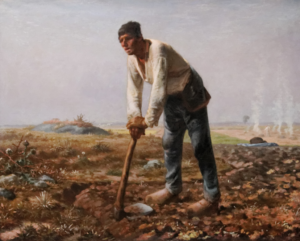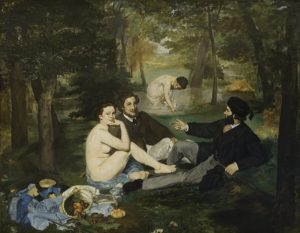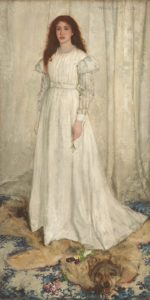For nearly a century and a half, the Paris Salon stood as the most esteemed art exhibition in the world. Though it was originally established as a show for the recent graduates of the Académie des Beaux-Arts, over time, it became a space where artists from across Europe and North America would compete to not only have their works chosen for exhibition but to have their works judged by a jury of Academy faculty. The Salon and those who ran it became the arbiters of artistic taste. Renoir once wrote, “In Paris there are scarcely fifteen art-lovers able to appreciate a painter outside the Salon. And there are 80,000 who wouldn’t buy a picture of the nose on their face if it wasn’t painted by a Salon artist.” In other words, why do you need a good eye for art when the Academy jury makes all the decisions for you?
The Salon became such an authority in the arts that it became nearly impossible to make a living as an artist in Europe, and France particularly, without being chosen for exhibition. Of course, this caused a bit of discontent among artists, especially those who were not working within more established genres, which were mainly realist, academic styles like historical scenes, landscapes, portraiture, and still lifes. Of course, this was a perfectly suitable arrangement for artists who did work within those genres, like Eugène Delacroix, Jean-Baptiste Camille Corot, William-Adolphe Bouguereau, and Jean Léon Gérôme. However, the Académie des Beaux-Art often excluded many painters seeking to experiment with different subjects and new techniques. But 1863 became a pivotal year for these artists.
That year, the Academy made their choices, selecting several thousand works including some by Corot and Gérôme, as well as Jean-François Millet and Charles Daubigny. However, when the Academy released its selections, many realized they had rejected nearly two-thirds of all submitted works. While the complaints and protests of rejected artists normally fell on deaf ears, they did manage to make their way to one of the people who had the authority to do something about it. Emperor Napoleon III was known for being incredibly sensitive to public opinion and often felt the need to please absolutely everyone. So, in response, he decreed that a separate salon be curated for all those rejected by the Academy jury. And it certainly is fortunate that the emperor took action because then Paris would have been deprived of some of the earliest modernist masterworks. The two paintings most often considered the exhibition’s best were listed in the catalogue as Le bain and Dame blanche. These two works would be popularly known as Édouard Manet’s Luncheon on the Grass and James McNeill Whistler’s Symphony in White No. 1.
One hundred sixty years ago, on May 15, 1863, the Salon des Refusés, or the Salon of the Rejected as it came to be known, opened to the public, attracting around a thousand visitors each day it was open. The salon included a mixed bag of artworks. Still, one of the most represented groups was the early modernists, including Édouard Manet, Camille Pissarro, Johan Jongkind, Henri Rousseau, and James McNeill Whistler. Exhibitions of rejected Salon entries had been held before, but they were always privately staged by artists themselves, most notably Gustave Courbet when the jury rejected many of his works. Furthermore, these private salons were never held on the scale of the Salon des Refusés.
The Salon des Refusés was held only twice more, in 1864 and 1873. Even though the Salon des Refusés was a compromise to appease protesting artists, it ended up being the beginning of the end for the Salon. The rejected works being exhibited formed the cracks in the ultimate authority of the Académie des Beaux-Arts as the final judges of artistic quality. French society could now view the paintings and sculptures considered subpar or even distasteful by the jury, leading many to decide for themselves whether the jury’s final selection had any merit. Furthermore, the Salon des Refusés showed that it was possible to exhibit works outside the Salon successfully.
After the initial Salon des Refusés, the Academy juries became less and less strict, but that was not enough for many artists. The Salon des Refusés became a sort of rallying cry for artists whose works were continually rejected by the Academy juries, though their pleas were often ignored or rejected. This was especially true for the members of the nascent Impressionist movement, leading these artists to band together to form the Anonymous Cooperative Association of Painters, Sculptors, and Engravers. This group eventually organized the first independent Impressionist exhibition in 1874. By 1881, the Salon was no longer a state-backed event, instead being placed in the care of a private organization, the Société des Artistes Français. And finally, by 1890, the Société des Artistes Français had fractured into several rival organizations, and the single, unified Salon was no more. Exhibitions were still commonplace across Paris, instead being put on by a number of different artists’ organizations like the Société des Artistes Indépendants, the Salon d’Automne, and the Société Nationale des Beaux-Arts.
The Salon des Refusés was originally meant as a bone thrown to the artists rejected from the main Salon. But it ended up becoming a turning point, heralding the arrival of modernism to Western art. It led to greater democratization within the arts, and the development of different movements like Pointillism, Fauvism, Expressionism, and Cubism, all of which would lead to abstract art and the other styles of the twentieth and twenty-first centuries. We owe a tremendous debt to the artists who fought to be seen.




